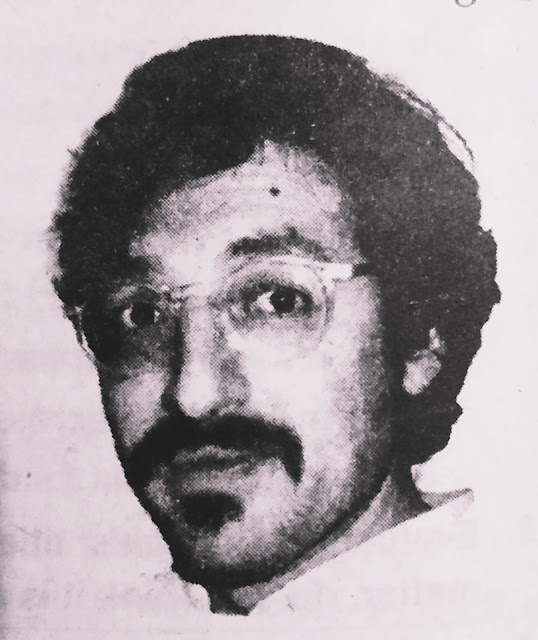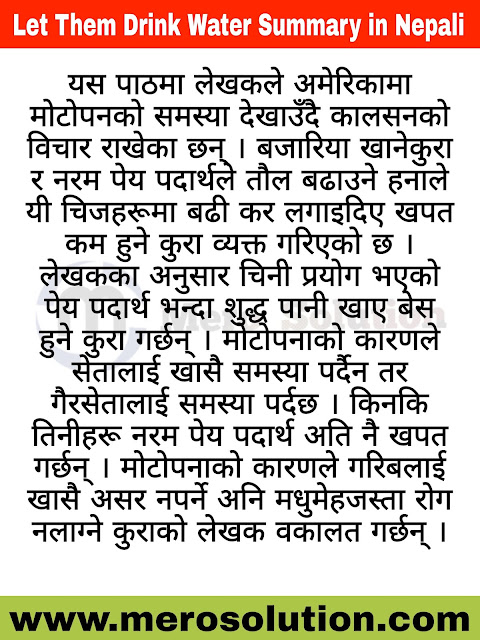Let Them Drink Water Summary And Question Answers
***********************************************************************
Contents :
1) Summary of Let Them Drink Water in English
2) Summary of Let Them Drink Water in Nepali
3) Question Answers of Let Them Drink Water
3.1) Comprehensive Question Answers of Let Them Drink Water
3.2) Purpose and Audience Question Answers of Let Them Drink Water
3.3) Style and Structure Question Answers of Let Them Drink Water
***********************************************************************
Summary of Let Them Drink Water in English
- Daniel Engber
In "Let Them Drink Water!", the author Daniel Engber writes that in 1942 Carlson suggested that they should impose a fee about overweight. Now it's mentioned again. Though it's not accepted by the public, it has an impact on people's life already. Then Daniel uses some facts to support it. He gives an example that junk food tax will be natural like cigarettes. After that, he talks about the disadvantages of junk food by experts' ideas. He says that junk food should be regarded as drags and he tries to make a difference between junk food and healthy food for people to choose. He also shows that imposing fat tax is benefit to the poor because some people think that it's unfair to poor people. So it's a way which can reduce obesity problems and increase the government's income so that it can be used to solve other problems. Finally, Daniel writes about the limitations of imposing the tax.
In Daniel Engber's, "Let Them Drink Water! What a Fat Tax Really Means for America", is an article trying to tie people into the idea of "fat tax." Since we are about to spend about $1 trillion on health care on our second-most expensive war, Engber's explains to us how commentators want to put tax on fat people and the junky foods and soft drinks that we eat and drink every day. They are thinking of adding tax on junk foods and soft drinks so that consumers will soon decrease their spending amounts on these items and even make the people in America with "health, wealth, and obesity." Obesity is a big problem in America and think that if they add taxes to these junky items, people will not buy them as much and overeating and diabetes rates will decline. Engber states that junk food is like cigarettes and we can get addicted to them. We sometimes just eat for pleasure and this is what makes us fat. Companies are trying to persuade the consumers to eat and buy the products and design and make the foods look good for us to want it. Engber thinks that these "sugar sweetened beverages are not necessary for survival" and we could always just drink water which is free or little cost and is not destructive like these other products we put into our bodies. Raising taxes to these things will make people not want them and will help people and their health. Daniel Engber explains that "fat tax" will mostly affect "mostly the nonwhite people who drink a lot of soft drinks and most sensitive to prices".
***********************************************************************
Summary of Let Them Drink Water in Nepali
***********************************************************************
Question Answers of Let Them Drink Water
A. Comprehension :
Q.1. According to Engber, what is the public's attitude toward taxing junk food and soda? How does he support this generalization?
ANSWER : Engber says that people generally are wary of the "fat fax". He says that legislation that has been implemented on the state level has not yet resulted in reducing obesity, and that efforts to make such legislation effective on a wider scale has received too much pushback to be implemented.
Q.2. Policymakers and public health experts who support taxing junk food draw an analogy between junk food and cigarettes. According to Engber, what redefinition does the analogy require?
ANSWER : Engber says that for this analogy to work, junk food needs to be framed like a drug. Junk food's ability to rewire the brain and to become truly addictive needs to be emphasized.
Q.3. What does Engber find "ironic" about "so many advocates for healthy eating"? In paragraph 10, Engber discusses the organic food movement. How does he define its "central dogma"?
ANSWER : Engber says that the "central dogma" of the organic food movement is that it's possible to be a "foodie" and to be healthy at the same time; you just must eat real and natural foods.
B. Purpose and Audience :
Q.1. What is Engber's purpose? Is he writing to change his readers' minds, to propose a course of action, to influence public policy, to inform his readers - or to provoke them? Explain.
ANSWER : Engber's main purpose seems to be to change the way his readers think about the idea of taxing soft drinks. He does not believe that there is a problem in regulating potentially dangerous chemicals/behaviors, but wants his readers to recognize the class issue at play with such regulations.
Q.2. Where does Engber think his audience stands on the issues he discusses? Does he see them as knowledgeable or uninformed? Does he think they are more likely to eat junk food or pain au levain? How can you tell?
ANSWER : Engber seems to assume that his audience is familiar with the "fat tax" proposals on a basic level, but that they have not thought about the intricacies of the proposal in the same way that he has. He begins his essay mostly neutral and informative, coming across as lightly skeptical of the proposals he discusses; he shows that he understands the intentions of such ideas. He continues to slowly bring up problems with such solutions, then begins to discuss the problem with the double standard to which we hold foods. He likely believes that some of his audience might fall into the "pain au levain"-eaters he describes. He is quite focused on challenging the commonly-held beliefs of this group, and likely does so because he believes that he is writing to some of them.
Q.3. In paragraph 14, Engber notes a lack of clarity about the effects of "sin taxes on behavior. How does this lack of clarity strengthen his argument?
ANSWER : This strengthen's Engber's point that such a tax might have little effect on obesity rates and public health and serve only as a burden on the poor:
C. Style and structure :
Q.1. What is the purpose of paragraphs 2 and 3? Why are they important to Engber's argument?
ANSWER : Paragraphs 2 and 3 serve to demonstrate how the proposals Engber discusses are being generally received. This helps give the reader an idea of the scale and relevance of the ideas he writes about.
Q.2. In paragraph 6, Eighner states his purpose: to record what he has learned as a Dumpster diver. What additional purposes do you think he had in setting his Ideas down on paper?
ANSWER : Eighner likely wrote this essay largely as a form of self-expression; it serves as an outlet for his creativity and his feelings during his homelessness. He also may have written with the intention of lessening the stigmatization of "dumpster divers" and to provoke empathy and understanding in the reader.
Q.3. Engber ends his essay with a surprising analogy. What two things is he comparing? Is this comparison logical? What point does it make?
ANSWER : Engber compares taxing some addictive foods and not others has parallels to the government giving significantly lighter prison sentences to cocaine dealers when compared to crack dealers. This comparison makes sense. Both pomegranate juice and soda contain enough sugar to be addictive in similar ways, but one is more associated with the white and wealthy than the other. The same could be said about cocaine and crack. He is pointing out how the law tends to punish the poor for things that the wealthy are not punished equally for.
***********************************************************************









0 Comments